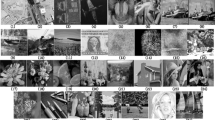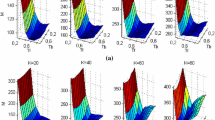Abstract
Compressed sensing gains great attention in the field of signal reconstruction. In order to deal with some practical cases in which the sparsity levels are unknown, this paper proposes an energy-based adaptive matching pursuit (EAMP) algorithm for binary sparse signal reconstruction in the compressed sensing framework. The EAMP algorithm inherits the feature of the sparsity adaptive matching pursuit algorithm, which increases the estimated sparsity level when the energy of the observation residue increases. Meanwhile, the proposed algorithm introduces the measurement vector into the signal reconstruction process. It uses two kinds of step sizes to increase the estimated sparsity level when the energy of the estimated candidate signal is less than half of that of the measurement vector. The experimental results indicate that the proposed EAMP algorithm provides better reconstruction performance than other greedy algorithms.














Similar content being viewed by others
Notes
The reconstruction results of the CoSaMP are similar to those of the SP in the setup, so CoSaMP is not included in the simulations.
References
Candès, E.J., Tao, T.: Near-optimal signal recovery from random projections: universal encoding strategies. IEEE Trans. Inf. Theory 52(12), 5406–5425 (2006)
Candès, E.J., Romberg, J., Tao, T.: Robust uncertainty principles: exact signal reconstruction from highly incomplete frequency information. IEEE Trans. Inf. Theory 52(2), 489–509 (2006)
Çetin, A.E.: Reconstruction of signals from Fourier transform samples. Signal Process. 16, 129–148 (1989)
Çetin, A.E., Ansari, R.: Signal recovery from wavelet transform maxima. IEEE Trans. Signal Process. 42–1, 194–196 (1994)
Purkait, P., Chanda, B.: Morphologic gain-controlled regularization for edge-preserving super-resolution image reconstruction. Signal Image Video Process. 7(5), 925–938 (2013)
Petrović, P.B.: New method and circuit for processing of band-limited periodic signals. Signal Image Video Process. 6(1), 109–123 (2012)
Candès, E.J., Wakin, M.B.: An introduction to compressive sampling. IEEE Signal Process. Mag. 25(2), 21–30 (2008)
Tsaig, Y., Donoho, D.L.: Extensions of compressed sensing. Signal Process. 86(3), 533–548 (2006)
Donoho, D.L.: Compressed sensing. IEEE Trans. Inf. Theory 52(4), 1289–1306 (2006)
Bi, X., Chen, X.D.: Image compressed sensing based on wavelet transform in contourlet domain. Signal Process. 91(5), 1085–1092 (2011)
Qu, X.B., Guo, D., Ning, B.D., Hou, Y.K., Lin, Y.L., Cai, S.H., Chen, Z.: Undersampled MRI reconstruction with patch-based directional wavelets. Magn. Reson. Imaging 30(7), 964–977 (2012)
Balouchestani, M., Raahemifar, K., Krishnan, S.: Low sampling rate algorithm for wireless ECG systems based on compressed sensing theory. Signal Image Video Process. (2013). doi:10.1007/s11760-013-0476-8
Meng, J., Yin, W., Li, H., Houssain, E., Han, Z.: Collaborative spectrum sensing from sparse observations using matrix completion for cognitive radio networks. 2010 IEEE International Conference on Acoustics Speech and Signal Processing (ICASSP), March (2010)
Haupt, J., Bajwa, W.U., Rabbat, M., Nowak, R.: Compressed sensing for networked data. IEEE Signal Process. Mag. 25(2), 92–101 (2008)
Guo, D., Liu, Z., Qu, X.B., Huang, L., Yao, Y., Sun, M.T.: Sparsity-Based online missing data recovery using overcomplete dictionary. IEEE Sens. J. 12(7), 2485–2495 (2012)
Guo, D., Qu, X.B., Huang, L.F., Yao, Y.: Sparsity-based spatial interpolation in wireless sensor networks. Sensors 11(3), 2385–2407 (2011)
Günay, O., Töreyin, B.U., Köse, K., Çetin, A.E.: Entropy functional based online adaptive decision fusion framework with application to wildfire detection in video. IEEE Trans. Image Process. 21(5), 2853–2865 (2012)
Youla, D.C., Webb, H.: Image restoration by the method of convex projections, part I-theory. IEEE Trans. Med. Imaging MI 1(2), 81–94 (1982)
Boyd, S., Vandenberghe, L.: Convex Optimization. Cambridge University Press, Cambridge (2004)
Yin, W., Osher, S., Goldfarb, D., Darbon, J.: Bregman iterative algorithms for applications to compressed sensing. SIAM J. Imaging Sci. 1(1), 143–168 (2008)
Cai, J.-F., Osher, S., Shen, Z.: Linearized Bregman iterations for compressed sensing. Math. Comput. 78(267), 1515–1536 (2009)
Daubechies, I., Fornasier, M., Loris, I.: Accelerated projected gradient method for linear inverse problems with sparsity constraints. J. Fourier Anal. Appl. 14, 764–792 (2008)
Tropp, J., Gilbert, A.: Signal recovery from random measurements via orthogonal matching pursuit. IEEE Trans. Inf. Theory 53, 4655–4666 (2007)
Needell, D., Vershynin, R.: Uniform uncertainty principle and signal recovery via regularized orthogonal matching pursuit. Found. Comput. Math. 9(3), 317–334 (2009)
Dai, W., Milenkovic, O.: Subspace pursuit for compressive sensing signal reconstruction. IEEE Trans. Inf. Theory 55, 2230–2249 (2009)
Needell, D., Tropp, J.A.: CoSaMP: iterative signal recovery from incomplete and inaccurate samples. Appl. Comput. Harmon. Anal. 26(3), 301–321 (2009)
Do, T.T., Gan, L., Nguyen, N.: Sparsity adaptive matching pursuit algorithm for practical compressed sensing. Asilomar Conference on Signals, Systems, and Computers, Pacific Grove, California (2008)
Nakarmi, U., Rahnavard, N.: BCS: compressive sensing for binary sparse signal. Military Communications Conference, Orlando, November (2012)
Iwen, M.A., Spencer, C.V.: A note on compressed sensing and the complexity of matrix multiplication. Inf. Process. Lett. 109, 468–471 (2012)
Mallat, S., Zhang, Z.: Matching pursuits with time-frequency dictionaries. IEEE Trans. Signal Process. 41(12), 3397–3415 (1993)
Mallat, S., Davis, G., Zhang, Z.: Adaptive time-frequency decompositions. SPIE J. Opt. Eng. 33, 2183–2191 (1994)
Kutyniok, G., Eldar, Y.C.: Compressed Sensing: Theory and Applications, 20–21. Cambridge University Press, Cambridge (2012)
Acknowledgments
This work is supported by the National Natural Science Foundation of China under the Grant No. \(61171015\). And it is also supported by China Postdoctoral Science Foundation under the Grant \(2013M531554\).
Author information
Authors and Affiliations
Corresponding author
Appendices
Appendix 1: The fixed step size \(s_{fix}< \frac{K}{2}\)
Let \(T\) denote the support of original signal and \(i\) be the iteration index. It is assumed that the measurement matrix satisfies the RIP and the \(mth \) iteration is the last one of the stage \(\Vert \mathbf {x}_{\Omega }\Vert ^{2}_{2}\le \frac{1}{4}\Vert \mathbf {y}\Vert ^{2}_{2}\) . Note that \(1^{2}+1^{2}+0+0+1^{2}=1+1+0+0+1\). Let \(\mathbf {z}\) be a \(0-1\) binary signal, we have
When \(\Vert \mathbf {x}_{\Omega }\Vert ^{2}_{2}\le \frac{1}{4}\Vert \mathbf {y}\Vert ^{2}_{2}\) , the step size is increased by \(s^{i}=2^{i}\) and the estimated sparsity level is updated by \(k^{i+1}=k^{i}+s^{i}\). For example,
Therefore,
When \(\Vert \mathbf {x}_{\Omega }\Vert ^{2}_{2}\le \frac{1}{4}\Vert \mathbf {y}\Vert ^{2}_{2}\), by Theorem 1 and (8), one has
and
Furthermore, when \(i\le m\), we get
The step size \(s_{fix}\) is fixed at the \(mth \) iteration with \(s_{fix}=s^{m}\).
Therefore, at the \(mth \) iteration
By invoking (10), it follows that
Hence,
which completes the proof.
Appendix 2: The procedure will move into the stage of\(\frac{1}{4}\Vert \mathbf {y}\Vert ^{2}_{2}<\Vert \mathbf {x}_{\Omega }\Vert ^{2}_{2}\le \frac{1}{2}\Vert \mathbf {y}\Vert ^{2}_{2}\) as soon as the step size is fixed
The proof is proved by contradiction. It is still assumed that the \(m\)th iteration is the last one of the stage \(\Vert \mathbf {x}_{\Omega }\Vert ^{2}_{2}\le \frac{1}{4}\Vert \mathbf {y}\Vert ^{2}_{2}\). Suppose that the procedure will move into the stage of \(\Vert \mathbf {x}_{\Omega }\Vert ^{2}_{2}>\frac{1}{2}\Vert \mathbf {y}\Vert ^{2}_{2}\) at the \((m+1)\)th iteration.
At the \((m+1)th\) iteration, \(\Vert \mathbf {x}_{\Omega }\Vert _{0}=k^{m+1}\) and \(\Vert \mathbf {x}_{\Omega }\Vert ^{2}_{2}>\frac{1}{2}\Vert \mathbf {y}\Vert ^{2}_{2}.\)
By invoking (8), it follows that
This result is a combination of (10) and (13). Therefore,
According to “Appendix 1,” \(s_{fix}=k^{m}\) and \(k^{m}\le \frac{1}{4}\Vert \mathbf {y}\Vert ^{2}_{2}\). Therefore,
It is perceived that (15) clearly contradicts (16). Thus, the process will move into the stage of \(\frac{1}{4}\Vert \mathbf {y}\Vert ^{2}_{2}<\Vert \mathbf {x}_{\Omega }\Vert ^{2}_{2}\le \frac{1}{2}\Vert \mathbf {y}\Vert ^{2}_{2}\) as soon as the step size is fixed.
Rights and permissions
About this article
Cite this article
Bi, X., Chen, X., Li, X. et al. Energy-based adaptive matching pursuit algorithm for binary sparse signal reconstruction in compressed sensing. SIViP 8, 1039–1048 (2014). https://doi.org/10.1007/s11760-014-0614-y
Received:
Revised:
Accepted:
Published:
Issue Date:
DOI: https://doi.org/10.1007/s11760-014-0614-y




